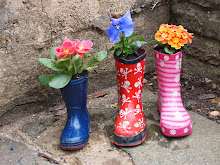We stayed at the museum for an hour or so while Garden Girl was with Garden Dad, watching the big screen for the very first time. So engaged was Garden Boy with the objects, that we only managed to look through two of the galleries. We didn't look at a map, but just wandered into rooms, which happened to be the 'Living and Dying' themed gallery and the North American gallery.
All the objects in the Living and Dying gallery relate in some way to how different cultures approach the challenges of maintaining health and diverting troubles in a spiritual way. There is an abundance of carved objects on display and Garden Boy was thrilled to look at the faces carved in wood, looking at the different features and facial expressions. There was also lots of colour and pattern in the gallery which provided a delightful focus for a little boy proud to be able to tell me the names of the shapes and colours he was seeing, pointing with a twinkle in his eye when he knew he was going to get it right.
Many of the objects were large so it was easy for Garden Boy to explore and engage with objects on his own, although there was also a lot that I had to lift him up to see. Aside from 'wow' his second most repeated word as we wandered the galleries was 'More' as he searched for more fantastic things to see. What impressed me most about this gallery for visiting with toddlers however, was the inspiration the objects gave me for follow up activities. We will be building our own papier mache tree of life on which Garden Boy will hang photos and magazine cutouts of images that are important to him. We will also be getting out the face paints and drawing designs on our cheeks similar to the ones carved and painted on many of the wooden figures we saw. We will be getting out the fabric paints to create our own geometric designs like those on the clothes we saw in the North American gallery and we will be making our own rattles with different faces drawn on them, using paper plates.
I really wanted to buy a glossy photo book with the objects we saw to discuss with both Our Little Museum Visitors when doing these activities but it was time to meet Garden Girl and Garden Dad for lunch so I didn't really have time to browse the shop. I will however, be looking online for images to use and heading over to our local library for books with similar images as soon as Garden Boy is recovered from the sickness bug he has been struck down with this week. And it won't be long before we return to the musuem with Garden Girl to show her what we saw and explore some more.
Practicalities
- Steps lead up to the main museum entrance but just round to each side of these steps there are llift which will take you up to the top level. These lifts are suitable for pushchairs and wheelchairs, although it isn't immediately obvious how to make them work and they have the sensation of being quite rickety and unstable while they are moving. I should say though, that they do move very slowly and are in reality very safe.
- Signs show very clearly where to go to access the lifts.
- There is a level entrance from Montague Place if preferred.
- There are disabled toilets and baby changing facilities throughout the museum as well as baby feeding areas for breast feeding mums.
- Most of the galleries and all the special exhibitions are accesssible by lifts which are located in the Great Court.
- The museum can get very busy so it is essential to keep toddlers close by, as despite the large spaces, it is easy to lose sight of them amongst all the legs.
- As there is so much to see I would also suggest avoiding some of the more popular galleries, such as the Egyptians, at the weekends when the number of people getting in the way can make it frustrating for toddlers who can't really see round all the people.
- The museum does run a number of free trails and handling sessions for families so it is worth visiting their website before visiting to find out more if you want your visit to be more focused.
- There is no parking at the museum although it can be possible for disabled visitors to arrange parking facilities with the museum if they phone in advance.
- The museum is also within the congestion zone and there is very little parking on the nearby roads so it is advisable to get to the museum by public transport. Details of the nearest tube stations and bus stops can be found on the British Museum website.
- There are cloakroom facilities but there is a charge of £1.50 per item to leave things here. Fold away pushchairs are free to leave at the cloakroom but with the cost of leaving changing bags and any additional baggage you might have lugged with you to keep the children entertained on the train/bus I prefer to take the pushchair with me through the galleries.
- There is a museum shop onsite and online.
- Admission to the museum is free, although there are sometimes charges for special exhibitions
- Open daily, 10am till 5.30pm
- Closed on 1st January and 24th - 26th December
To find out more or to check for updated information prior to your visit, have a look at the British Museum Website.
Little Museum Visitor Rating
****

